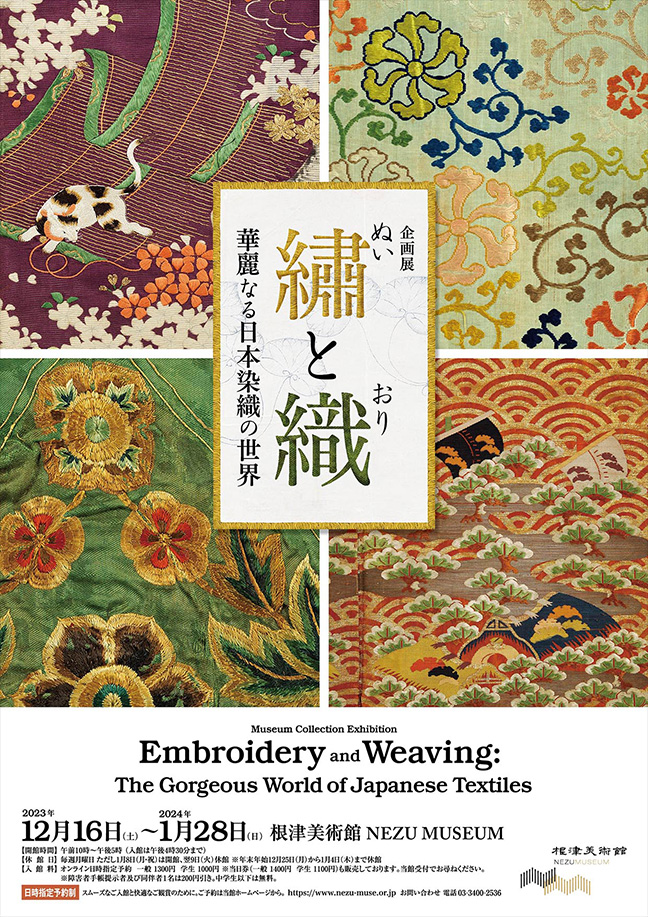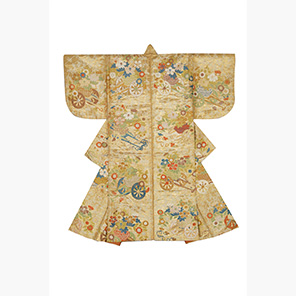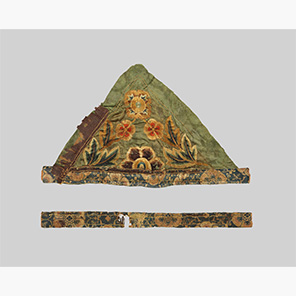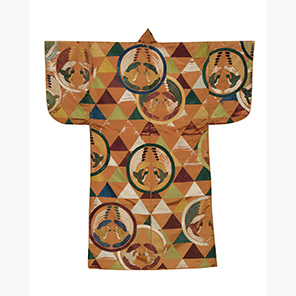HOME > Exhibitions > Past
-
Museum Collection Exhibition
Embroidery and Weaving
The Gorgeous World of Japanese Textiles - Saturday, December 16, 2023 – Sunday, January 28, 2024


| Closed | Mondays and Dec. 25 – Jan. 4 for the New Year holidays |
|---|---|
| Hours | 10 a.m. - 5 p.m.(last entry: 4:30 p.m.) |
| General admission (On-line timed-entry tickets) | Adult 1300 yen, Student 1000 yen |
| Gallery | 1/2 |
The use of diverse forms of weaving and embroidery to decorate textiles has long been regarded in Japan as a marker of high status. Throughout the ages, embroidery and dyeing have been combined to embellish kosode (short-sleeved kimono) and massive, dignified weaves frequently used in Noh costumes. The foundation of the Nezu Museum collection was laid by Nezu Kaichirō, Sr. (1860-1940), who was renowned for his magnificent collection of classic art and whose passion for collecting included textiles. In this exhibition, we introduce a wide range of works, primarily from Kaichirō’s collection, that display the brilliance of weaving and embroidery techniques, including ancient textile fragments preserved at Hōryūji Temple and the Shōsōin Repository, Buddhist kesa (stoles) and altar cloths, karaori and nuihaku (embroidery and gold or silver foil) Noh costumes, and Edo-period kosode.
During the year’s biggest turning point, from year end to the new year, please enjoy this cornucopia of gorgeous and majestic textiles.

- Karaori Noh Costume with Weeping Cherry Blossom and Flower Carts Design on Gold Ground
- Japan Edo period, 19th century
- The orientation of the larger motifs combining weeping cherry blossoms and flower carts changes in each section. There are many magnificent karaori Noh costumes, but the use of gold throughout makes this costume not only gorgeous but noble as well.

- Embroidery with Flowering Plant Design on Green Ground
- Japan Nara period, 8th century
- The embroidery on the green ground of this triangular fragment creates a Chinese flowering plant design. This fragment is thought to be from the top of a banner displayed inside or outside a Buddhist temple to enhance its grandeur.

- Kitsuke Noh Costume with Triangles and Birds in Circles on Red Grounda
- Japan Momoyama-Edo periods, 17th century
- In this Noh costume, bold colors are used in the embroidery to create triangular motifs and large circles containing birds facing each other. The use of watashi-nui, couching stitch embroidery, and the narrowness of the sleeves compared to the body are characteristic of kosode from the late sixteenth to the early seventeenth century. Given that the kitsuke would be worn concealed under an outer garment, the exquisite embroidery that covers the entirety of this work is astonishing. (Exhibited for the first time.)

- Furisode Long-sleeved Kimono with Phoenix and Paulownia Design
- Japan Meiji period, 19th century
- In this set of three wedding furisode , the base fabrics are of different colors—white, red, and black—but all three display the same embroidery and kanoko shibori (dappled shaped resist dye designs ). They may have been made for a wealthy merchant inspired by the style of wedding garments held in great esteem by samurai households.










